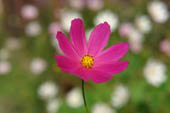
Purpose
To demonstrate the importance of plants stems for the purpose of their survival.
Additional information
Stems are one of two main structural axes of a vascular plant and are made up of nodes and internodes. Nodes hold plant buds, which eventually grow into leaves or flowers. Internodes act as a padding between nodes, keeping them at distance from one another. Roots are the other main structural axes of a plant.
Stems have several important purposes for plants. They provide support for the elevation of leaves and flowers, pushing them up into the sunshine to develop growth. They also act as the main artery to transport water from the roots, essentially feeding the plant and keeping it nourished. Furthermore, stems provide the storage of nutrients that are essential to the plants growth and healthiness.
Sponsored Links
Required materials
- 2 fresh flowers
- Scissors
- Pencil or pen
- Journal
Estimated Experiment Time
Less than 5 minutes to set-up, up to 3 days to observe results.
Step-By-Step Procedure
- 1. Cut the stem off of one of the flowers using the scissors.
- 2. Place your 2 flowers (1 with the stem, 1 without a stem) in a safe place/
- 3. After an hour, check the plants and write any noticeable differences in your journal.
- 4. Next wait 24 hours and check the plants again, notating the differences in your journal.
- 5. Repeat step 4 for an additional 2 days. What is happening to the plants?
Note
You'll need fresh flowers for the best results in this experiment. If you don't have any available in your house, feel free to hit the fields outside and pick some flowers you know are safe and free from thorns. Be courteous though... don't pick them from a neighbor’s garden!
Observation
Do the plants change after 1 hour? What seems to be the trend as each day passes? What do you think the plants will be like if you left them for a week? How about a month?
Result
The stem of a flower holds water. When flowers are in a vase or in the ground, the stem is what draws water up to keep their petals moist and healthy. Even when a vase is out of water or the ground is dry, the stem of the flower still holds water, nourishing the plant. When the stem was removed from one of the plants, its water source was literally cut-off. Without the water to draw up to the petals, the plant quickly dies. The plant that had the stem left in-tact can live much longer because it's still feeding off the water in the stem.
Sponsored Links
Take a moment to visit our table of Periodic Elements page where you can get an in-depth view of all the elements,
complete with the industry first side-by-side element comparisons!